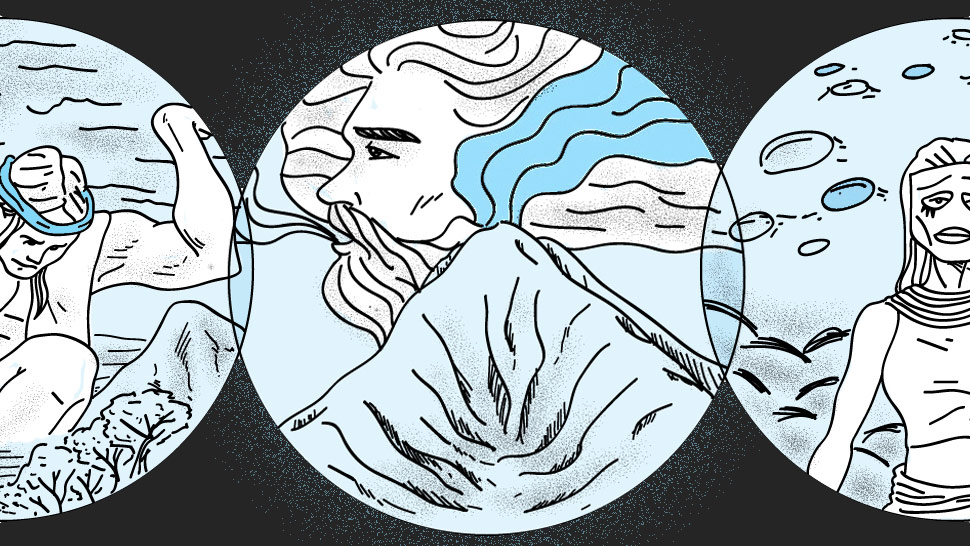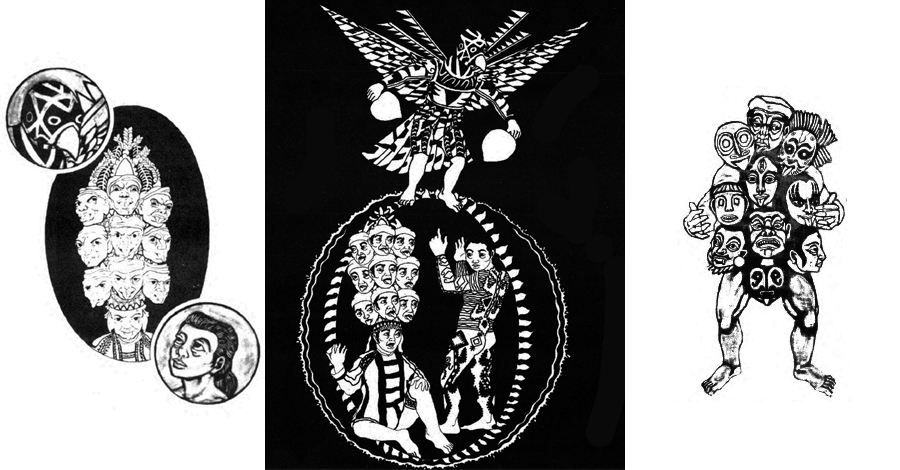Mythology is understood by many as being part of the cultural identity for particular regions – representing spirituality, beliefs and values in the form of stories from the reservoir of their collective imagination. But some scholars found that despite geographical distances between nations, mythologies had uncanny similarities and parallels in motifs, symbols and themes. This thinking became more mainstream through the work of Joseph Campbell, the proponent of the Monomyth theory, and psychologist C.G Jung, who weaved mythological figures into archetypes and introduced us to the idea that mythologies go beyond cultural boundaries.
In this article, we will examine how our very own Philippine Mythology shares commonalities found in various mythologies from around the world.
Parallel #1: World Axis
They say that in the universe, everything is connected. Folklore and legends around the globe hint at this thinking on a cosmic scale via the ever present symbol of Axis Mundi, or the center/axis that connects the sky (heaven) to earth. This symbol appears in a variety of objects in nature (mountain, trees), and often in body parts of a deity (i.e spine) when likened to a particular man-made object like pillars or towers. Mirca Eliade’s book called Image and Symbols describes some of the characteristics of the Axis Mundi in several mythologies: it is the place where the activities of gods are most intense, it is the passage from the lower world to upper the world of certain cosmology, the dwelling place of the dead and ancestral souls, and it is usually the place where shamans conducted their rituals and sacrifices.

Among the well-known structures and objects that serves as a symbolical Axis Mundi are Mt. Fuji – which is the highest mountain in Japan, Mt. Olympus – where the 12 Greek gods reside, the ancient Sumerian pyramids called Ziggurats, and even sacred architectural buildings such Cathedrals of the Roman Catholics and Stupa from Buddhist and Hindu beliefs.
Philippine Versions of The World Axis
In myths from the Mindanao Bukidnon, during the journey of a soul to the afterlife, Mt. Balatukan acts as the image for the Axis Mundi. This mountain houses the region called Dunkituhan at its summit where the good souls can find their eternal rest. Other similar natural structures that represent the center of the world are Mt. Kanlaon from Negrense Mythology, Mt. Banahaw of Laguna, Harigi Ka Kalibutan (Pillars of the World) which to some from Panay Island is believe to be a mountain range that supports the heaven. Further, the Balete tree was known as a place where shamans would often be found communicating with unseen spirits during their induction period, and there were even vines which were said to be used by the people from skyworld to travel in our land.

Other sacred mountains that served as the abode of pre-colonial Philippine gods includes Arayat where the goddess Sinukuan dwells, Mt. Makiling which is the abode of Maria Makiling and Mt. Apo where people offered sacrifices to Mandarangan for good health and victories in war.
The existence of pillars that support the world is also prevalent in Philippine mythology. These are notable in the stories of creator gods like Masiken from Cordillera and Makalindung of Eastern Mindanao who made the world atop a singular or multiple pillars to support it. Usually, these pillars are guarded by different kinds of animals like a giant crab, eel or pig wherein their movements were said to cause earthquakes.
Parallel #2: Giants as World Creators
Mythologies are populated with many fantastical beings with supernatural capabilities. Besides the heroes with magical abilities and the bizarre monsters they challenge, giants are also very well known in different mythical stories. Depicted as humanoid with an unusually large size, giants are often bringers of terror, but there are many instances that they play the role of cosmic creator as their body parts are transformed into land, sea or sky. Ymir, from Norse myth, was a hermaphrodite and could reproduce asexually; when he slept, more giants leapt forth from his legs and from the sweat of his armpits. In Chinese mythology, Pangu is usually depicted as a primitive, hairy giant who has horns on his head and wears fur. Pangu began creating the world: he separated Yin from Yang with a swing of his giant axe, creating the Earth (murky Yin) and the Sky (clear Yang). To keep them separated, Pangu stood between them and pushed up the Sky.

Philippine Versions of Giant Creators
The Ilocos creator, Angngalo, was a giant born from the fusion of heaven and earth and created the world at the command of the supreme god. Who this god was, the legends don’t mention. In the beginning the earth was all plain; there were no seas, no mountains, no hills, no valleys. Ang-ngalo dug the earth with his fingers, and with the earth he extracted, he formed the present mountains and hills. He urinated into the bigger and deeper holes and they became the present oceans and seas. He spat and the sputum became the first man and woman. He put them in a bamboo tube, sealed the tube, and cast it into the sea. The tube was tossed on the waves to the Ilocos shore, and the man and woman came out of it and lived in the Ilocos. Then he put up the sky, the sun, the moon, and arranged the stars.
The Manuvu god Manama molded the earth from the collected dirt under his fingernails which he patiently rolled and shaped. To make it fertile and ready for agriculture, Manama commanded his bird familiar, Limokon, to take fertile soil from the maligned god Ogassi.
The mythology of the Bilaan on the other hand has the great giant Melu occupying all the outer space. This white skinned titan used all the dead skin from his body to form the earth and the first people to dwell on it. He also taught these people to save all their hair clippings and dry skin sheds to create more people.

Image from the Soul Book courtesy of GCF books
Parallel #3: Trinitarian Gods
The concept of Trinitarian gods is well known through Catholicism. The explanation of the trinity is summed up as “one god in three divine persona” and thus retains its monotheistic nature.When it comes to ancient religions and mythology, the Trinitarian concept placed the three gods in separate bodies and gave them different functions. Such classic examples include the Hindu gods Vishnu, Shiva and Brahma who serves as the three primary gods in the polytheistic belief structure. In Egypt, there is Isis, Osiris and Horus who are all archetypes representing cosmic functions and dynamics, and were considered the “Holy Family”. According to Sumerian mythology, three gods hold domain over the sky, sea and land – Anu, Ea and Enlil. It’s a bit of a mystery as to what’s behind the number 3. Many affirm, including St. Jerome – one of the early Catholic theologians, that ‘all ancient nations believed in the Trinity’.
Philippine Version of the Trinity
According to Bukidnon Myth, in the beginning there was only a small circular space of intense brightness called a banting. It was surrounded by a rainbow and three beings. They are Diwata na Magbaya, the good being that looks like a mortal man, Dadanhayan ha Sugay, who has ten heads and was considered the ‘bad being’, and the last one is Agtayabun the winged being. One day Diwata na Magbaya decided to enlarged the Banting in order to become the sky. The soil and saliva coming from Dadanhayan ha Sugay became the earth through the help of Agtayabun. However, most of the time these three argued to the point that they ended up fighting with one another. To settle, it was decided that each of them will have the freedom to create separately. Diwata na Magbaya created the very first man, while Dadanhayan ha Sugay created six guardian nature spirits known as Incantus.

Parallel #4: Male and Female Duality
Another common theme observable in various myths and faiths from around the world is the dual aspect of male and female forces. The interplay of these two maintain balance and harmony in the cosmos and at times they are also responsible for the creation of the world itself, though many beliefs often cite a sole male creator. This duality theme is strongly emphasized in the Chinese ideology of Yin and Yang, represented by black and white. In the Japanese Shintō religion, the deities Izanagi and Izanami are known for creating the first bodies of land by stirring the primal sea. In Aztec mythology, Ōmeteōtl (“Two Gods”) is a name sometimes used to refer to the pair of Aztec creator deities Ometecuhtli and Omecihuatl.
Philippine Version of Male and Female Duality
Based on the study made by the Jesuit missionary Francisco Ignacio Alcina, the Warays in the Eastern Visayas believed in a deity which may have had two aspects – Malaon (Ancient One) who is depicted as an understanding goddess and Makapatag (the Leveller) who is a stern and fearful god.
Some ethnic groups in Mindanao have both male and female creators. When the creators disagree, it tends to be the female who prevails
According to Bisayan myth, at the very beginning there was nothing in the world except for the sea and sky and nothing in between. Within the world there was only the sky God, Kaptan, and the sea Goddess, Magwayen. They fought each other intensely and violently, Magwayen throwing her strong typhoon waves up toward the sky and Kaptan throwing large rocks and lighting back down. This long, bitter feud between the two deities lasted for a long time, until one day they drew the sea and sky closer together and created the islands. The sea and sky deities ceased their fighting, coming together as friends and eventually lovers. After they married, Kaptan planted a seed in the sea where it soon grew to become a bamboo reed. Out of the bamboo emerged Si Kalak, the first man, and Si Kabay, the first woman.
Stories That Connect Cultures
Parallels in different mythology doesn’t dissolve the individuality of each culture it belongs to. However, it does elicit a certain truth that goes beyond the dream like narratives of these stories about gods and monsters: that mythology is universal and allows us to not just preserve our own culture, but to help us understand others.
Source:
Myth and Symbols Philippines by Fr. F.R Demetrio, S.J (Revised Edition)
Introduction to Philippine Pagan Religion: Soul Book by Fr. F.R Demetrio S.J, Gilda Cordero-Fernando, Fernando N. Zialcity (1991)
www.newworldencyclopedia.org/entry/Axis_Mundi.com
“How Trinitarian Gods Influenced Adoption of the Trinity” by (from ucg.org)
“Massive Similarities between Different World Mythology” by Kanika Kalra (from edtimes.in)
ALSO READ: THE BUKIDNON TRINITY: Creation of the Universe
Currently collecting books (fiction and non-fiction) involving Philippine mythology and folklore. His favorite lower mythological creature is the Bakunawa because he too is curious what the moon or sun taste like.


